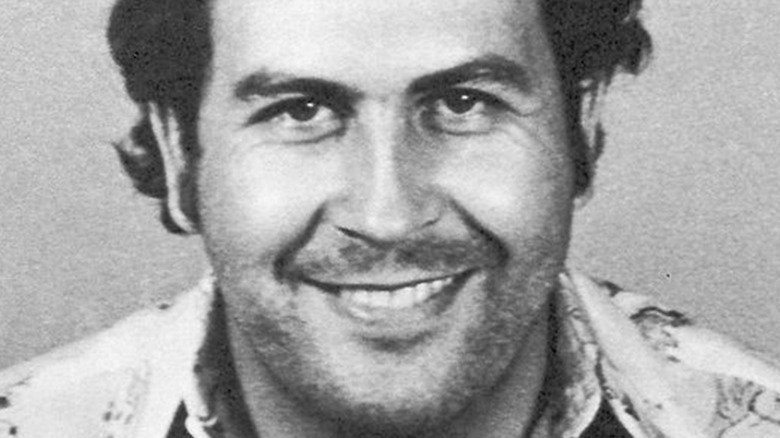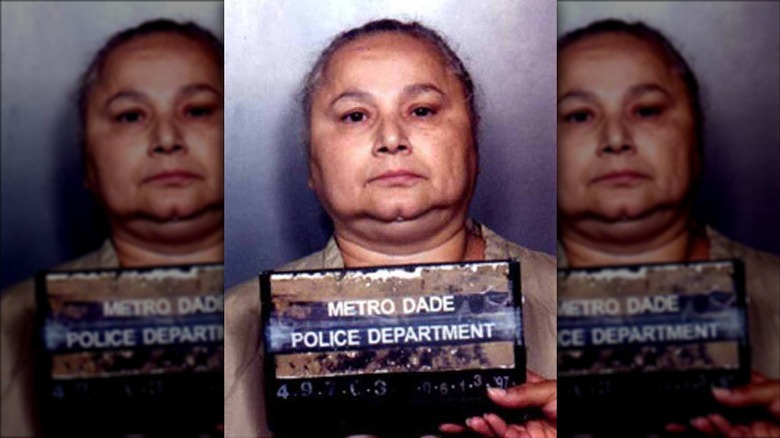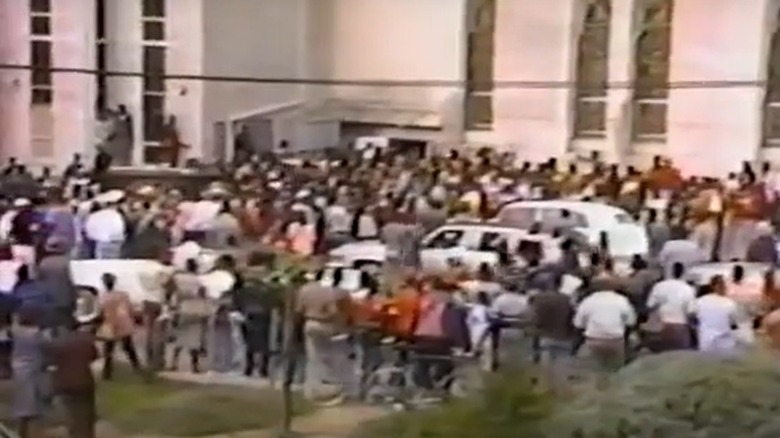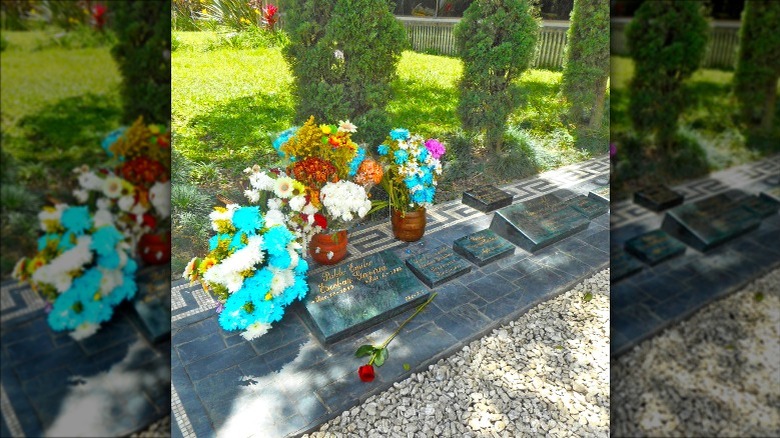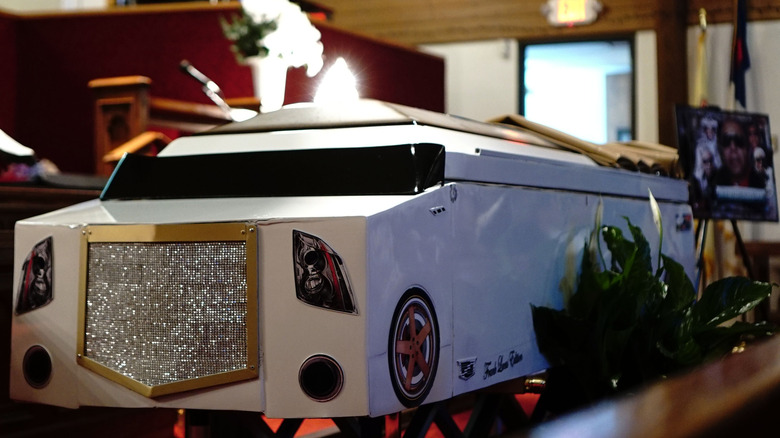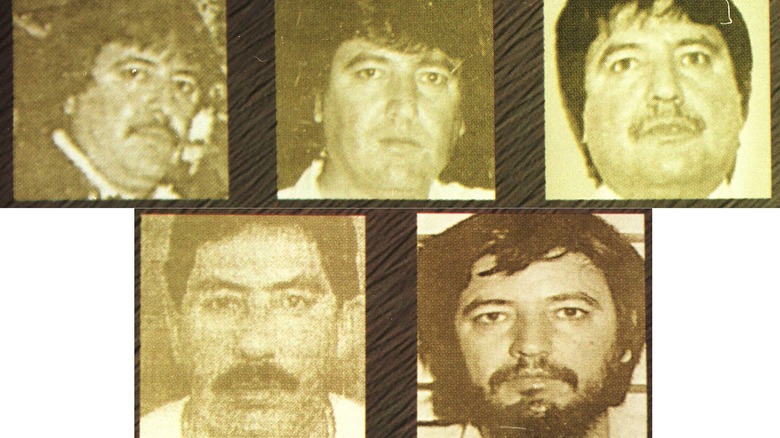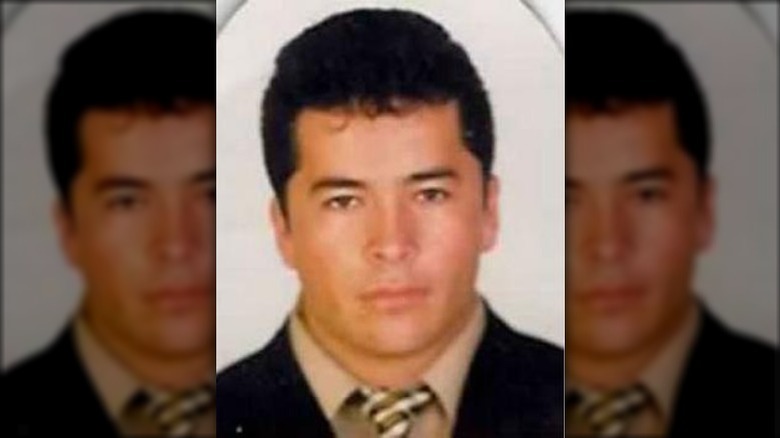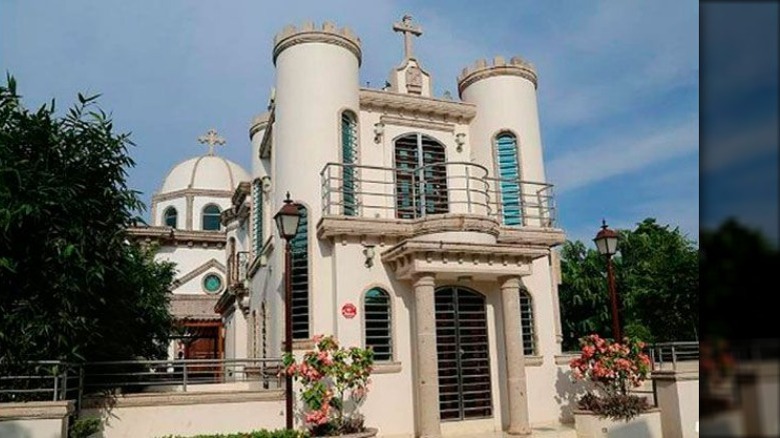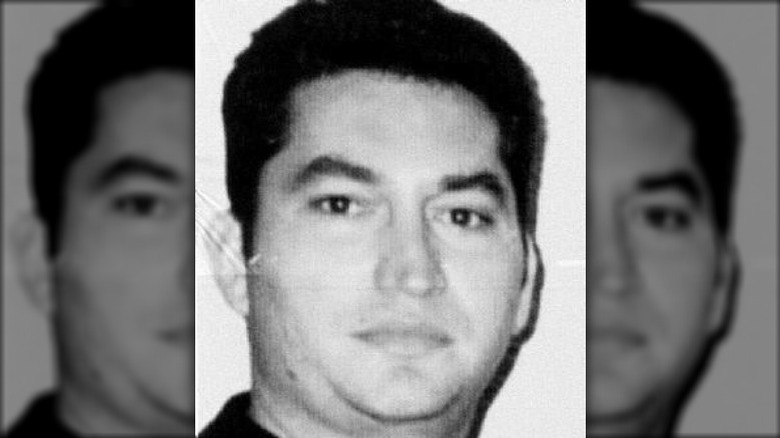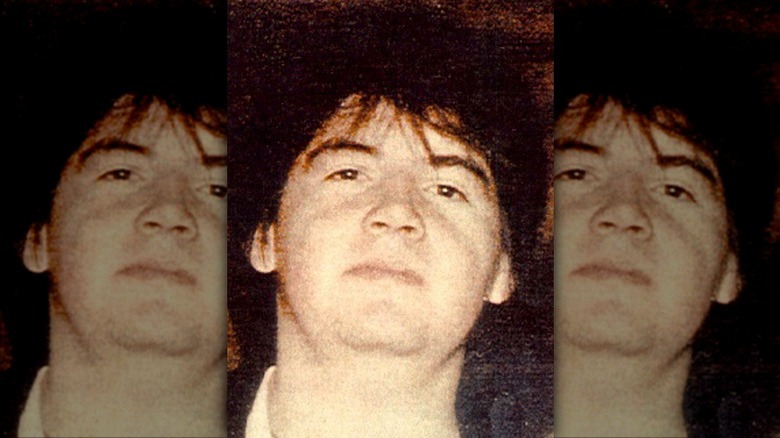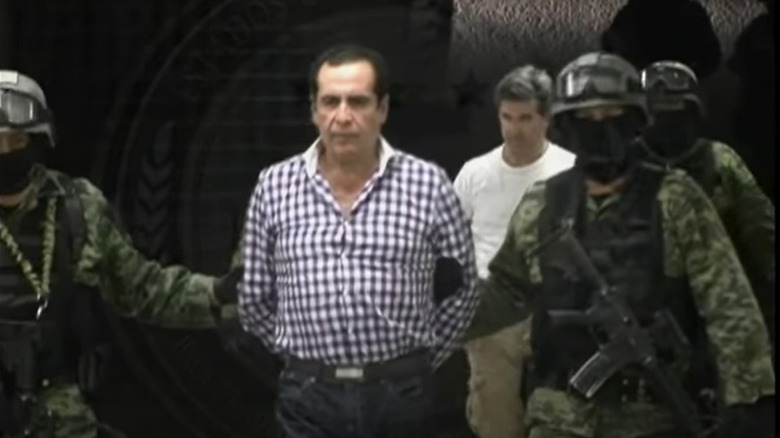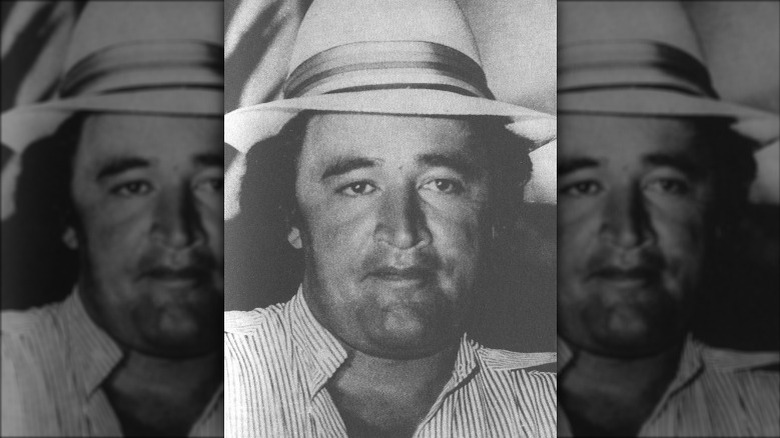Here's What Happened To The Bodies Of These Drug Lords
Your high school guidance counselor probably never brought up "drug lord" when talking about possible career paths. While some of the most powerful drug traffickers out there were born into the life, most fell into it by being in the right place at the right time (or rather, the very, very wrong place at the totally wrong time). However they ended up as leaders of criminal organizations, these drug lords knew the danger their business brought to themselves and those around them. So while they probably didn't want to die violent deaths, they were aware it was a real possibility.
After those inevitable violent ends came to virtually all of them (the few that got to die in their beds at an advanced age should get some kind of medal), they had to be buried just like everyone else. Well, maybe not just like us regular people. Their wealth, notoriety, and power meant that some unexpected things happened to their remains – from being stolen from the morgue to being laid to rest in mausoleums that are more like mansions. Here's what happened to the bodies of these drug lords.
Griselda Blanco
On a list with mostly men, Griselda Blanco might be the most sadistic and vicious drug lord of all. She killed at least one, and possibly all three of her husbands, along with up to 200 other murders as she became the biggest cocaine trafficker in Miami during the 1970s and '80s.
Blanco was deported from the U.S. in 2004 after 15 years in prison, and returned to Colombia for a sort of semi-anonymous semi-retirement. But her many enemies didn't forget. In 2012, the 69-year-old was picking up what El Pais notes was a surprisingly large amount of meat from a local butcher. While she waited for her order, a man in a motorcycle helmet entered the store and shot her twice in the head. Ironically, drive-by motorcycle assassinations were a technique she pioneered in the drug trade. "It's some kind of poetic justice that she met an end that she delivered to so many others," University of Miami professor Bruce Bagley, author of the book "Drug Trafficking, Organized Crime, and Violence in the Americas Today," told the Guardian.
Two days later, Blanco was buried in the Cementerio Jardins Montesacro in Itagüí, Colombia, the same location as her biggest drug cartel rival (more on him later). Busloads of children were brought in for the funeral, while (hopefully adult) mourners shared bottles of liquor. One missing mourner was her son Michael, who was under house arrest for drug crimes in the U.S., per the Miami New Times.
Felix Mitchell
The California drug lord Felix Mitchell got the fabulous nickname "Felix the Cat," according to BlackPast. He grew up in the projects of Oakland, per the AP, where he turned selling heroin into an industry as head of the "69 Mob." Mitchell led a group of up to 30 people that sold the drug to locals and could make up to $1 million a month in 1980s dollars. They also killed at least half a dozen people, with prosecutors alleging Mitchell ordered many of those murders personally.
His arrest and conviction led to a sentence of life in prison without the possibility of parole in 1985. Just one year later, two days before he would have turned 32, Mitchell was stabbed 10 times by another inmate and died.
His funeral was national news. The coffin alone cost $6,000. The ushers at the church service attended by 1,800 people wore tuxedos. The LA Times reported that another 1,000 lined the streets to gawk at the 2-hour-long funeral procession of a horse-drawn carriage, Rolls Royces, and limos. Not everyone was happy about the spectacle. "They're trying to martyr him, this scumbag, this murderer, this convicted heroin dealer. As far as I'm concerned, justice was served. He got a life sentence, and that's what he did," Detective Everett Gremminger said before the funeral. One city council member called it a "Mafia glorification process" and a second said it was ″hero worship of a murdering thug," per the AP.
Mitchell was interred at Rolling Hills Memorial Park in Richmond, California (via Find a Grave).
Pablo Escobar
If you have only heard of one drug lord, it will be Pablo Escobar. The Colombia kingpin was infamous in his lifetime and has only become more so through the books, films, and other media covering his life and violent death. GQ reports that Escobar's cartel was responsible for 80% of the cocaine that made it into the United States at one point. He had a truly staggering fortune, using it to buy, among other things, "cocaine hippos" that are still causing havoc in Colombia today.
Escobar was killed in a shootout with police in 1993, the New York Times reported. His funeral was an "insane circus," per the New York Daily News. The New York Times described it as a "rancorous mob." Mourners trying to get into the church broke the windows and then crawled over glass to touch the silver coffin. Eventually, they picked it up and carried it to the graveyard. Many locals saw him not as a violent drug lord but as a generous and charitable man. "He built houses and cared about the poor," one young mourner said. "In the future, people will go to his tomb to pray, the way they would to a saint."
That tomb is really a simple, flat stone in the Cementerio Jardins Montesacro in Itagüí, Colombia, the same location his drug trade competition Griselda Blanco is buried. Visitors still come by the thousands, some proudly doing cocaine off his gravestone and posting the images and videos online, per Atlas Obscura and the Independent. In 2006, Escobar's body was exhumed for DNA testing by his family, to prove he hadn't faked his death.
Frank Lucas
Most people could only dream of having the great and gorgeous Denzel Washington play them in a film about their life, but it was a dream the "Godfather of Harlem" got to see realized in 2007 with the release of "American Gangster," according to his obituary. Frank Lucas Sr. grew up in North Carolina before moving to Harlem, where, according to the Atlanta Journal-Constitution, he brought heroin into the country from Southeast Asia, becoming one of the major drug lords of the 1970s.
Lucas eventually got out of the game, managing to live to 88, a real accomplishment among those on this list. Before he died in 2019, he contacted designer casket maker Fletcher Collins, per WRAL, and ordered one. Collins produced a $12,000 coffin reminiscent of a Cadillac CTS-V, with "a sliding roof top, head and taillights, and featured a North Carolina license plate."
After he died, Frank Lucas' nephew, the Rev. Jamal Harrison Bryant, gave the eulogy at his funeral. Perhaps knowing that people would question a man of God being part of a notorious drug lord's sendoff, Rev. Bryant posted on Instagram, "You get to pick your friends BUT God gets to pick your family! Tomorrow I'm delivering the eulogy for my uncle #franklucas. He flooded more drugs into the country than anyone in the 70s at end of his life he was advisor to many on alternatives to street life. It's not how you start but how you finish" (via the AJC).
Lucas was interred at Pinelawn Memorial Park Cemetery in Kinston, North Carolina.
Amado Carrillo Fuentes
During his career as a drug trafficker, according to the Washington Post, Amado Carrillo Fuentes led a multi-billion-dollar operation, making him one of the richest guys in Mexico, and one of the world's most powerful drug lords. This is where you probably expect to learn he went out in a hail of bullets, cut down by police like so many others in his profession. The truth is far weirder: he died in 1997 while getting plastic surgery.
Fuentes' funeral was swarming with cops and the military, who took photos of mourners and even frisked some. The family was not happy. "He always said they'd never take him alive," his sister Alicia said. "Now that he's dead, they've come for him." But the kind of men the authorities were probably expecting to find at the funeral weren't there, with the mourners mostly being made up of local farm workers.
Fuentes was buried in Culiacán's Panteón Jardines del Humaya. British tabloid The Sun reports his half-million-dollar mausoleum includes a 50-seat chapel. Of course, if you believe the conspiracy theories, it's not the drug lord who is laid to rest in such opulence, but one of his subordinates, with the plastic surgery that "killed" Fuentes really performed on a cartel henchman to make him look like the drug lord. This man, the theory goes, was then murdered and passed off as his boss. Adding to the mystery, the three surgeons working on Fuentes (or whomever it was) when he died were all found dead in barrels of concrete only a few months later, per the Washington Post.
Heriberto Lazcano
After serving in the Mexican Special Forces, Heriberto Lazcano changed sides and became an assassin for the Gulf cartel, before being killed in a shootout with authorities in 2012, per NPR. Photos and fingerprints were taken, and the drug lord's body was left at a funeral home. Then it was stolen.
Still, the Mexican government assured everyone it was really Lazcano, even if they no longer had the body to prove it. The authorities were so determined to prove they'd killed him and it wasn't another death-faking situation that The World reports they exhumed Lazcano's parents to compare DNA. So if there's DNA evidence, why doesn't the public know about it? Mexican newspaper 24 Horas (via InSight Crime) tried to get the results but were told there was a 12-year embargo due to an ongoing criminal investigation, and the results would not be released until 2024.
If it is Lazcano who was killed, he was laid to rest in luxury, even if he's too dead to enjoy it. His mausoleum at Culiacán's Panteón Jardines del Humaya cemetery cost around half a million dollars, according to the British tabloid The Sun. Despite the fact Lazcano was a murderer who, it is claimed, would then eat part of the people he killed, the 3-story tomb has a "heavy religious theme."
Arturo Beltrán Leyva
The British tabloid The Sun notes that Mexican drug lord Arturo Beltrán Leyva was best known for "his huge wealth." Still, at some point, even money can't protect those in that dangerous profession. The man who smuggled tons of cocaine into the U.S. and earned the nicknames "The Boss of Bosses" and "The Beard," according to Reuters, eventually had his luck run out. He was killed by Mexican forces in a raid in 2009.
Despite a commercial-size airliner being hired to fly his body back to his home in Culiacán from Mexico City, Beltrán Leyva's funeral was small by drug lord standards. No men attended the service at Panteón Jardines del Humaya cemetery, for fear of being arrested, and the funeral was far from the "raucous" event the locals had expected. However, his mausoleum was anything but subdued. The Sun reports that the 2-story building is more like a mansion, complete with "Wi-Fi, satellite TV, air con, two bedrooms, and [a] kitchen." Reuters notes that these kinds of tombs are also usually "full of photos, plastic flowers, balloons, replica guns, and model cars."
There is a tragic postscript to Beltrán Leyva's story: the raid that took out him and six of his men had another casualty, a young Mexican Marine. The man was buried a week later as a national hero, according to NPR, but just hours after his grieving family returned home from his funeral, they were murdered in their home, a revenge killing by Beltrán Leyva's cartel.
Nazario Moreno Gonzalez
Mexican authorities were thrilled in 2010, when they added Nazario Moreno González, co-head of the La Familia cartel, to their growing list of captured or killed drug lords. "Several pieces of information signal that he was shot Thursday," said Alejandro Poiré Romero, a spokesman for the Mexican government announced, via the New York Times.
So it was extremely unexpected when they announced in 2014 that Moreno González had been killed – again. Turns out they weren't right the first time. There hadn't even been a body back them, per the BBC. But this wild tale was just one of many in the life of the drug lord known as "El Mas Loco" – The Craziest One. In life, he dressed in white robes and formed a cult of personality around himself. His followers venerated him as if he was a saint, according to Time.
But as much as he might have thought he was God, it turned out he was mortal in the end. The second time he was killed, the authorities had a body and they made very sure. "From a fingerprint analysis we have confirmed 100% that this was Nazario Moreno Gonzalez," said Tomas Zeron of the Mexican federal prosecutor's office, via the BBC. But his body has disappeared yet again, at least to the wider world, as the family did not say where they were burying him, although some sources believe he was cremated.
Ramón Arellano Félix
At least one drug lord managed to fake his death, so you can imagine that this is something authorities have to watch out for. Their job was made especially difficult in this area when it came to Ramón Arellano Félix. The Mexican drug lord had the distinction, such as it were, of appearing next to Osama bin Laden on the FBI's Most Wanted List from 2001-2002, per the BBC.
But bin Laden would manage to hide from the law almost a decade longer than Félix. In 2002, Félix, despite being in charge of the Tijuana Cartel, decided to micromanage the murder of one of his rivals, traveling with some of his cartel members to do the killing. However, before he got the chance to take out the fellow drug lord, he ran into the cops, who took Félix himself out.
Or rather, it was a guy they are pretty sure was Félix. One of the two men whom the police killed in a shootout was carrying ID that said he was "Jorge Pérez Lopez." However, he was in possession of a gun that had killed two judges and for various other reasons was identified as Félix. Since he was dead, the authorities should have had plenty of time to make sure. But then someone claiming to be a relative picked up the body at the funeral home and immediately had it cremated. However, after DNA testing blood from the man's clothes, authorities said they were "virtually certain" the dead man was the drug lord, according to the New York Times.
Héctor Beltrán Leyva
If the name Héctor Beltrán Leyva sounds familiar, that's probably because his brother Arturo Beltrán Leyva is also on this list. Together, they ran the eponymous Beltrán Leyva cartel, along with their two other brothers Alfredo and Carlos, according to the BBC. But Héctor was the last one to find himself caught by police, as eventually Arturo was dead and the other two in jail. Known as "El H," Héctor took over full control of the cartel in 2009, until he was finally arrested on drug trafficking charges in 2014.
Perhaps surprisingly, it was not Héctor's vicious rivalry with notorious drug lord Joaquín "El Chapo" Guzmán that did him in. While in jail awaiting trial in 2018, Héctor started having chest pains. Despite guards immediately administering first aid, per NBC News, and then rushing him to the hospital, Héctor died of a heart attack aged 56.
El Sol de Mexico reported that his body was flown by Lear jet to the town of Hermosillo, where it was held on the "VIP" floor of a mortuary under tight security. This secrecy seems to have extended to the eventual disposition of the remains, as, according to Find a Grave, it's not known where Héctor's body eventually ended up, or if he was cremated.
José Gonzalo Rodríguez Gacha
José Gonzalo Rodriguez Gacha was another drug lord who was seen as charitable by those in his hometown, in this case Pacho, Colombia. The New York Times says that he paid to renovate buildings in the town, but he made that money as the No. 2 guy in the Medellin cartel.
Rodriguez Gacha was killed along with his son and five of his bodyguards in a shootout with police in 1989, and all seven were quickly buried in a mass grave, before being exhumed two days later and returned home. There, anywhere from 3,000-15,000 mourners paraded through the streets, although the funeral itself was limited to family only. His remains were interred in the local cemetery in a "luxurious" wooden coffin, per the AP.
Or was he? Two years after his death, the Chicago Tribune spoke to residents of the town and a lot of them seemed pretty sure the drug lord was still alive and had faked his death. He was even said to have gotten in better shape and attended his own birthday party. The paper explained that even those who claimed not to believe the conspiracy theory said so "with a pinch of doubt and much fear." "They never showed his face on television when he died," the head of the local hospital, Dr. Antonio Ramirez said. "The funeral was held at night, and the coffin was closed. That`s not done in Colombia. It`s possible they buried somebody else in his grave."
